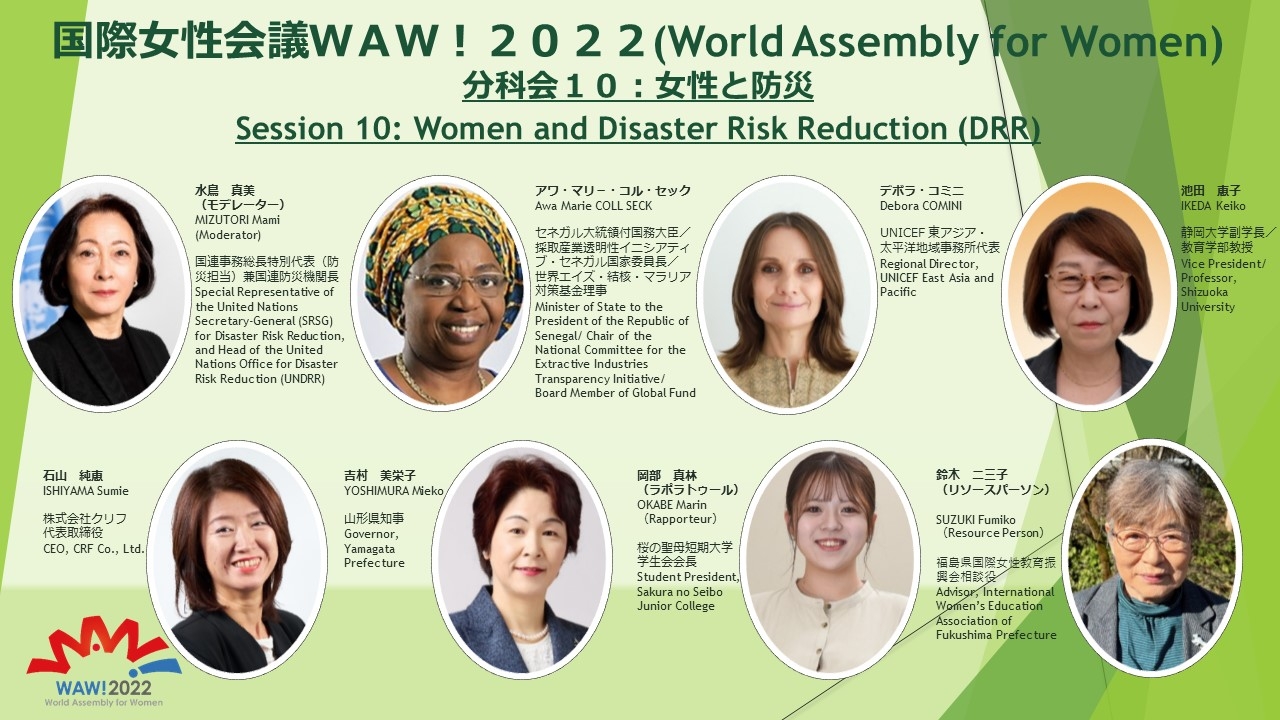Women's Empowerment and Gender Equality
World Assembly for Women: WAW! 2022
Concept Note
Women and Disaster Risk Reduction (DRR)
Participants (Regularly Updated)

- MIZUTORI Mami, Special Representative of the United Nations Secretary-General (SRSG) for Disaster Risk Reduction, and Head of the United Nations Office for Disaster Risk Reduction (UNDRR) (Moderator)
- Awa Marie COLL SECK, Minister of State to the President of the Republic of Senegal/ Chair of the National Committee for the Extractive Industries Transparency Initiative/ Board Member of Global Fund(virtual)
- Debora COMINI, Regional Director, UNICEF East Asia and Pacific
- IKEDA Keiko, Vice President/ Professor, Shizuoka University
- ISHIYAMA Sumie, CEO, CRF Co., Ltd.
- YOSHIMURA Mieko, Governor, Yamagata Prefecture
- OKABE Marin, Student President, Sakura no Seibo Junior College (Rapporteur)
- SUZUKI Fumiko, Advisor, International Women’s Education Association of Fukushima Prefecture (Resource Person)
Current situation and challenges to be discussed
The risk of natural disasters has been increasing globally in recent years. According to the UNDRR's Human Cost Disaster report, the number of large-scale natural disasters worldwide has increased by about 1.7 times in the 20 years from 2000 to 2019, compared to the period from 1980 to 1999(note1).
Women tend to be in difficult situations in various phases of disasters, i.e. when a disaster occurs, during evacuation, and during recovery and reconstruction phases. It is known that more women than men lose their lives in disasters because women tend to delay in evacuation while protecting children and the elderly(note2). In developing countries, many deaths in females occur due to reasons such as lack of access to evacuation information due to low literacy rates among women, and religious reasons causing inaccessibility of shelters to women(note3).
In shelters, women face difficulties in protecting their privacy, including in changing rooms and nursing rooms and in meeting their needs for supplies such as sanitary items, underwear, and breastfeeding items. Women are also often forced to take on the unpaid care works such as cleaning and cooking in shelters in association with gender stereotypes. In addition, increased risk of sexual harassment and sexual violence in evacuation facilities place women on a greater physical and mental burden(note4). It is also found that there are long-term negative effects that women have difficulty returning to work during the recovery and reconstruction period due to the burden of unpaid care roles in their home and communities(note5). Those adverse impacts on women during and aftermath of disasters are often amplified difficulties and challenges caused by gender inequalities that exist in normal times. Efforts must be made to eliminate gender stereotypes from normal times.
To improve this situation, it is important to promote women's engagement in policy-making processes in disaster response and disaster risk reduction (DRR). The Sendai Framework for Disaster Risk Reduction 2015-2030, adopted at the Third UN World Conference on Disaster Risk Reduction in 2015, reaffirmed the need to promote women's engagement in policy-making, planning, and implementation processes in order to achieve gender-responsive DRR. At the WAW! 2022, we will discuss how to engage women's perspectives to realize no one is left behind in DRR, based on the experiences of the Great East Japan Earthquake and other disasters, as well as the experiences of each country and region.
Discussion Topics
- What are the barriers that prevent women's participation and engagement in decision-making processes in disaster management and DRR, and what are some examples of overcoming these barriers? What measures we should take with a gender perspective when other countries or international organizations come to provide aid to an area where women are not fully engaged in DRR?
- What kind of support do local governments, fire departments, police and military (in Japan, Self-Defense Forces) provide to female employees to engage in disaster response? What are the barriers that prevent women from participating in disaster management and DRR? What measures and good practices are in place? What national and regional policies, as well as the organization as a whole, can support women's engagement in disaster management?
- What measures should be taken and strengthened to eliminate and prevent sexual harassment, sexual violence, and sexual crimes that may occur in various relationships among disaster victims and between them and supporters?
- What are some good examples of livelihood recovery and economic empowerment measures including securing employment for women during the recovery and reconstruction period?
- (note1) UNDRR, “The human cost of disasters: an overview of the last 20 years (2000-2019)”

- (note2) Center for Disaster Philanthropy, “Women and Girls in Disasters”

- (note3) Center for Disaster Philanthropy, “Women and Girls in Disasters”

- (note4) 内閣府男女共同参画局、“第5次男女共同参画基本計画第8分野防災・復興、環境問題における男女共同参画の推進” (PDF)
 (Japanese)
(Japanese) - (note5) 東日本大震災女性支援ネットワーク、“被災地の女性からの雇用に関するメッセージ”
 (Japanese)
(Japanese)

